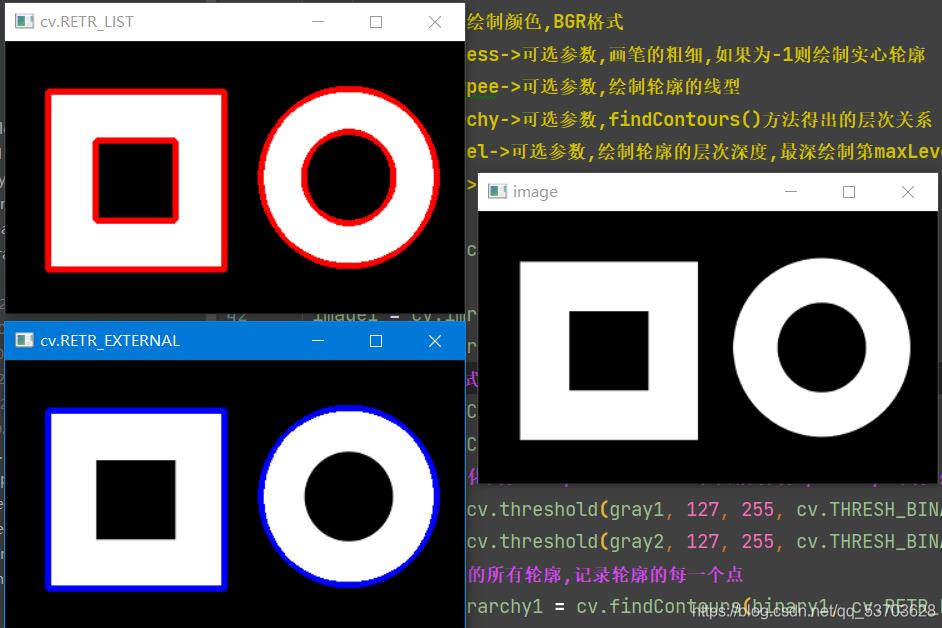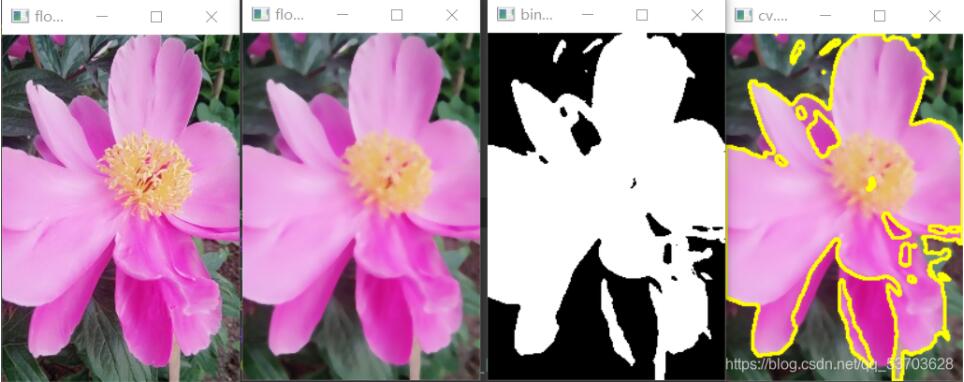本文实例为大家分享了检测几何图形轮廓和检测花朵图形轮廓,供大家参考,具体内容如下
opencv绘制图像轮廓
绘制轮廓的一般步骤:
1、读取图像
|
1
|
image = cv2.imread('image_path') |
2、将原图转化为灰度图像
|
1
|
image_gray = cv.cvtcolor(image, cv.color_bgr2gray) |
3、将灰度图像进行二值化阈值处理
|
1
2
|
# 这里将阈值设置为127为例,最大阈值为255t, binary = cv.threshold(image_gray, 127, 255, cv.thresh_binary) |
4、检测二值化图像中边缘轮廓
|
1
2
|
# 这里以检测所有轮廓,不建立层次关系为例contours, hierarchy = cv2.findcontours(binary, cv2.retr_list, cv2.chain_approx_none) |
5、在原图上绘制图像
|
1
2
|
# 这里将轮廓索引设置为-1,绘制出所有轮廓,颜色设置为红色,宽度为2为例cv2.drawcontours(image, contours, -1, (0, 0, 255), 2) |
6、显示图像
|
1
|
cv2.imshow('image', image) |
测试检测几何图形轮廓:
代码如下:
|
1
2
3
4
5
6
7
8
9
10
11
12
13
14
15
16
17
18
19
20
21
22
23
24
25
26
27
28
29
30
31
32
33
34
35
36
37
38
39
40
41
42
43
44
45
46
47
48
49
50
51
52
53
54
55
56
57
58
59
60
61
62
63
64
65
|
# -*- coding: utf-8 -*-# @time : 2021/8/17# @author : zyh"""introduction:图像轮廓检测: opencv提供的findcontours()方法可以通过计算图像梯度来判断出图像的边缘,然后将边缘的点封装成数组返回 contours, hierarchy = cv2.findcontours(image, mode, mothode) 参数: image->被检测图像必须是8位单通道二值图像。如果原图是rgb图像,必须转为灰度图像,在进行二值化阈值处理 mode->轮廓的检索模式 参数值 含义 cv2.retr_external 只检测外轮廓 cv2.retr_list 检测所有轮廓,但不建立层次关系 cv2.retr_ccomp 检测所有轮廓,并建立两级层次关系 cv2.retr_tree 检测所有轮廓,并建立树状结构的层次关系 mothode->检测轮廓时使用的方法 参数值 含义 cv2.chain_none 储存轮廓上的所有点 cv2.chain_approx_simple 只保存水平、垂直或对角线轮廓的端点 cv2.chain_approx_tc89_l1 ten_chinl近似算法的一种 cv2.chain_approx_tc89_kcos ten_chinl近似算法的一种 retval: contours->检测出的所有轮廓,list类型,每一个元素都是某个轮廓的像素坐标数组 hierarchy->轮廓之间的层次关系图像轮廓绘制: image = cv2.drawcontours(image, contours, contouridx, color, thickness, linetypee, hierarchy, maxlevel, offse) 参数: image->被绘制轮廓的原始图像,可以是多通道图像 contours->findcontours()方法得出的轮廓列表 contouridx->绘制轮廓的索引,如果为-1则绘制所有轮廓 color:绘制颜色,bgr格式 thickness->可选参数,画笔的粗细,如果为-1则绘制实心轮廓 linetypee->可选参数,绘制轮廓的线型 hierarchy->可选参数,findcontours()方法得出的层次关系 maxlevel->可选参数,绘制轮廓的层次深度,最深绘制第maxlevel层 offse->可选参数,偏移量,可以改变绘制结果的位置"""import cv2 as cv# 读取加载图像image1 = cv.imread('shape1.png')image2 = cv.imread('shape1.png')# 将图像由rgb格式转为灰度图像gray1 = cv.cvtcolor(image1, cv.color_bgr2gray)gray2 = cv.cvtcolor(image2, cv.color_bgr2gray)# 将图像进行二值化阈值处理, 返回t是处理时采用的阈值,binary是阈值处理后的图像t1, binary1 = cv.threshold(gray1, 127, 255, cv.thresh_binary)t2, binary2 = cv.threshold(gray2, 127, 255, cv.thresh_binary)# 检测图像中出现的所有轮廓,记录轮廓的每一个点contours1, hierarchy1 = cv.findcontours(binary1, cv.retr_list, cv.chain_approx_none)# 显示原图cv.imshow('image', image1)# 绘制所有轮廓,宽度为3,颜色为红色cv.drawcontours(image1, contours1, -1, (0, 0, 255), 3)cv.imshow('cv.retr_list', image1)# 检测图像中的外轮廓,记录轮廓的每一个点contours2, hierarchy2 = cv.findcontours(binary2, cv.retr_external, cv.chain_approx_none)# 使用cv2.retr_external做参数绘制外轮廓,宽度为3,颜色为蓝色cv.drawcontours(image2, contours2, -1, (255, 0, 0), 3)cv.imshow('cv.retr_external', image2)cv.waitkey()cv.destroyallwindows() |
运行结果:

测试检测花朵图形轮廓:
代码如下:
|
1
2
3
4
5
6
7
8
9
10
11
12
13
14
15
16
17
18
19
20
21
22
23
24
25
26
27
28
29
30
|
# -*- coding: utf-8 -*-# @time : 2021/8/18# @author : zyh"""introduction:绘制花朵所有轮廓"""import cv2 as cvimage_flower = cv.imread('flower.png')# 显示原图cv.imshow('flower1', image_flower)# 对图像进行中值滤波处理,去除噪声image_flower = cv.medianblur(image_flower, 5)cv.imshow('flower2', image_flower)# 将图像从rgb转为单通道灰度图像gray_flower = cv.cvtcolor(image_flower, cv.color_bgr2gray)# 灰度图像进行二值化阈值处理t, binary = cv.threshold(gray_flower, 127, 255, cv.thresh_binary)# 显示二值化图像cv.imshow('binary', binary)# 获取二值化图像中的轮廓以及轮廓层次contours, hierarchy = cv.findcontours(binary, cv.retr_list, cv.chain_approx_none)# 在原图中绘制轮廓cv.drawcontours(image_flower, contours, -1, (0, 255, 255), 2)# 显示绘制轮廓后的图像cv.imshow('cv.retr_list', image_flower)cv.waitkey()cv.destroyallwindows() |
运行结果:

以上就是本文的全部内容,希望对大家的学习有所帮助,也希望大家多多支持服务器之家。
原文链接:https://blog.csdn.net/qq_53703628/article/details/119779014










